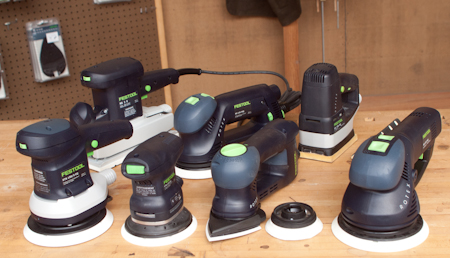 I get this question at least twice a week. Up until recently my advice has been pretty consistent. I'll get into that later. I get this question at least twice a week. Up until recently my advice has been pretty consistent. I'll get into that later.
This Blog entry was written in 2011 - Since then Festool has added new sanders to their range of products. Click here for an updated edition of this blog entry.
All the Festool sanders have fabulous dust control, and (except the 1/2 sheet sander) are available with a huge range of sandpaper. So your selection needs to be based on what you are sanding.
Unless you are doing something really weird you will normally want either a 5" or 6" random orbital sander. The overwhelming most popular Festool sander is the 5" diameter ETS 125. It's light, powerful, and has a finest sanding pattern (2mm) of all the sanders mentioned here. Like all Festool orbital sanders it's a true random orbital. The reason it's so darn popular is that most people are using sanders on sheet goods so they really just need a great finishing sander, and the ETS 125 is light, and internally balanced for smooth operation. These are important features if you sand all day - Light is light and the balance means you don't get the constant vibration in your hands which is so fatiguing. Of course the 5" disks are a little less expensive than larger disks.
If you do anything rougher get the 6" ETS 150/3. That sander has of course a larger pad but also a larger more aggressive stroke. Actually there are two versions the 3mm stroke and the 5mm stroke. Almost everyone gets the 3mm except people who use them to touch up floors and other rough work. I suppose that if you work in solid stock and don't hand plane the wood you also might want the 6" 5mm stroke version because 3mm version is less aggressive.
Festool also makes Rotex Sanders which can be used in either fine or coarse mode. In general they are special purpose tools. While for some occasional users having the extra versatility is a great thing, for regular use the extra weight of the Rotex sanders is a downer because usually you will be finish sanding. Almost everyone getting a larger Rotex gets the 6" but we sell a few 5" Rotexes mostly because if you are using a lot of 5" ETS 125 sanders in your shop already not having to stock another size of sandpaper is a good thing.
There is one new addition to the Rotex lineup which has changed my thinking. The new Rotex 90 has only a 3/12" pad. But it also comes with a triangular pad for getting into corners and the combination has been a massively popular tool.
Why so popular? Like I said, dor your average finish sanding people are getting either the ETS 125 or 150. Then they add to that the Rotex 90 and they have a regular light sander for doing regular work and the Rotex 90 in rotary mode for aggressive sanding, paint and rust removal, and polishing. The smaller head size is just great for precisely removing rust etc. The smaller head also makes polishing detail stuff much easier. But the deal closer is the triangular head. Getting into corners isn't an everyday requirement but when it is having a sander that can really work tight spots is a wonderful complement to the larger workhorse machines.
Festool also sells a linear sander which is a godsend for sanding molding. A half sheet sander for those you you who are doing big panels all the time. And a few other specialty sanders which are worth looking into but not what I would ever recommend as a first tool.
We stock all the festool sanders and all the sizes and varieties of sandpaper to go with them.
In the picture above, clockwise starting at the lower right:
6" Rotex 150, new Rotex 90 with both triangular and round pads, 5" most popular ETS 125, 6" ETS 150, 1/2 sheet RS 2E , 5" Rotex 125, Linear LS 130.
I'll write something soon about selecting sandpaper.
(PS - we of course stock all these sanders, accessories, sandpaper and offer free delivery anywhere in the US on Festool orders over $150).
|
 Joel's Blog
Joel's Blog Built-It Blog
Built-It Blog Video Roundup
Video Roundup Classes & Events
Classes & Events Work Magazine
Work Magazine






















 I get this question at least twice a week. Up until recently my advice has been pretty consistent. I'll get into that later.
I get this question at least twice a week. Up until recently my advice has been pretty consistent. I'll get into that later.